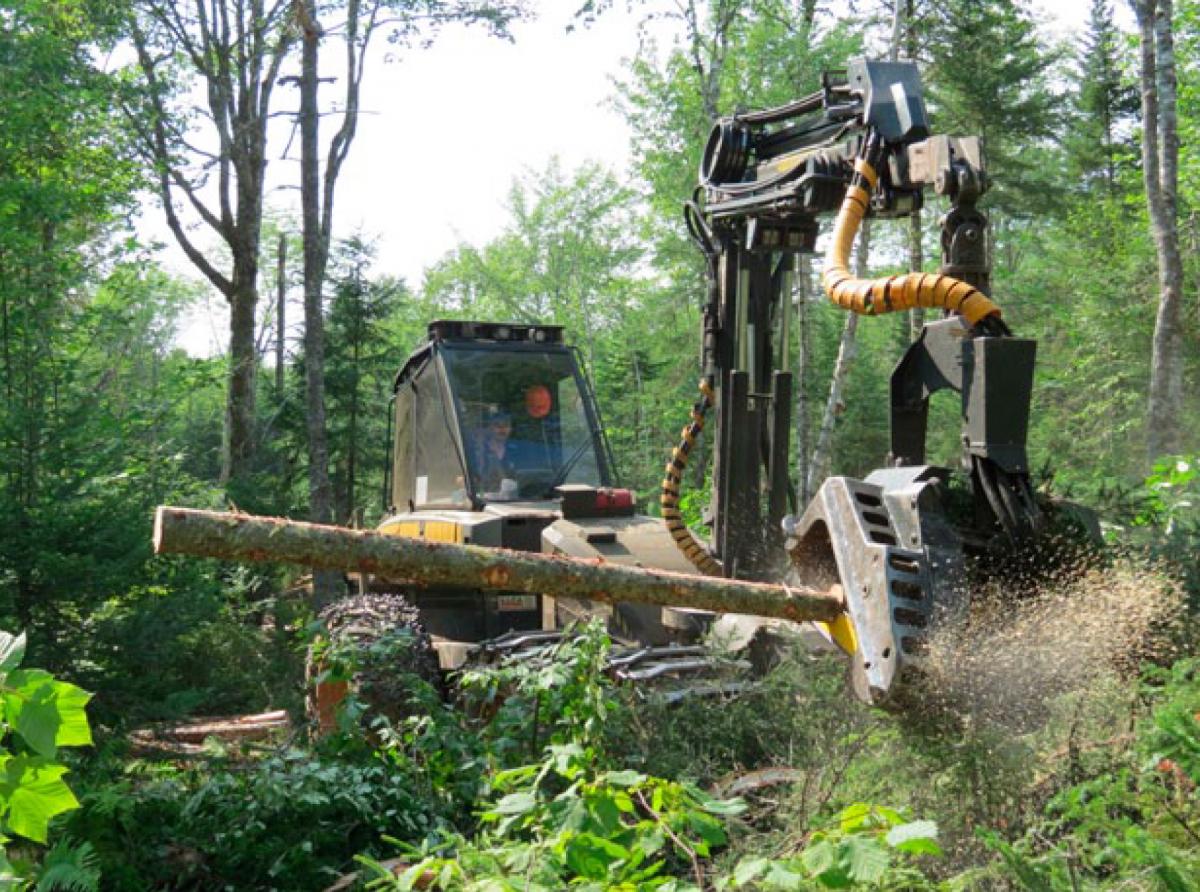Module 2: Harvesting on Your Woodland
Lesson Three - The Selection System
|
|
| A harvesting processor removing balsam fir from a mixedwood stand |
Harvesting Equipment
Much of the equipment that is used in harvesting timber in Nova Scotia is highly mechanized and requires skilled operators. Most operators undergo training to learn how to operate equipment efficiently and effectively. Modern equipment requires technical knowledge and good operators take pride in their work.
Although less common, harvesting trees manually by chainsaw is still present on many private woodlands. Even in mechanical operations, chainsaw operators are valuable for felling residual trees and those trees which a processor cannot handle, such as trees with heavy limbs or crooked stems.
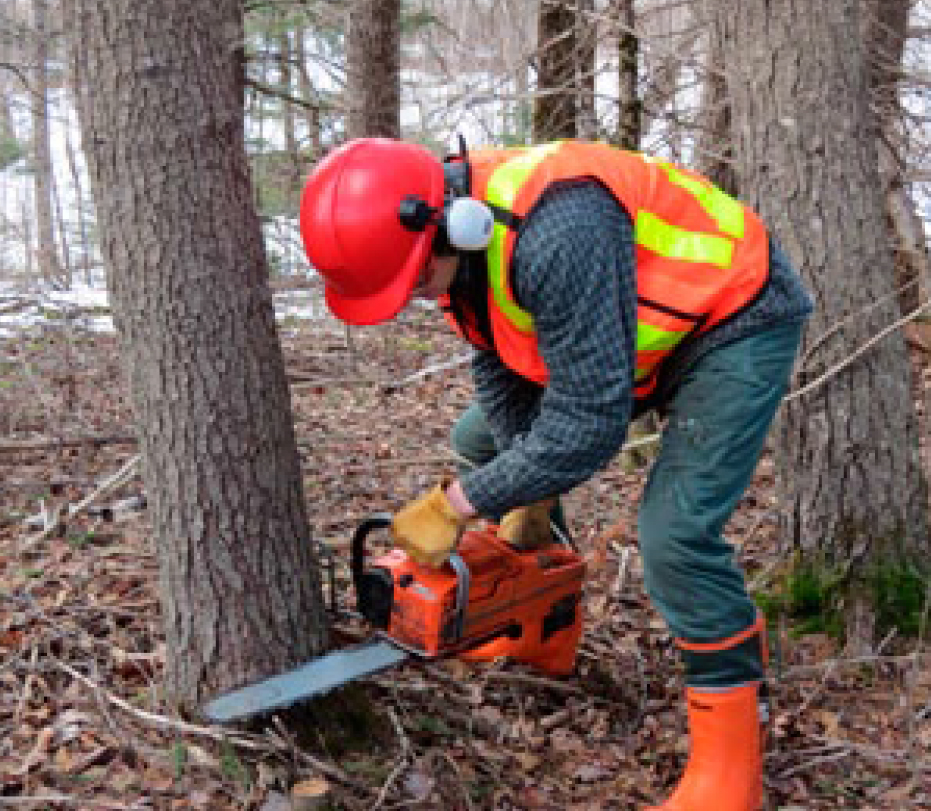 |
| Chainsaw operators are more difficult to find nowadays, but many would cut a tree no other way |
There are advantages and disadvantages to both mechanical and manual harvesting methods:
Mechanical Harvesting – advantages
• Greater volumes of wood can be harvested in a relatively shorter period of time
• Work environment is less physically demanding with better ergonomics
• Work environment is safer
• Dimensions of product are often more consistent
Mechanical Harvesting – disadvantages
• High cost of equipment
• Relatively large harvest area is often required to justify cost of moving heavy equipment
• Sites and seasons must be chosen with care to avoid soil compaction and rutting
Manual Harvesting – advantages
• Ability to harvest trees in a relatively small area
• Low cost of equipment
• Flexibility of extraction method (forwarder, skidder, horse or other small extraction equipment)
• Where product value is high, as in the case of hardwood veneer, sawlogs and specialty products, operator is able to custom-cut the product
Manual Harvesting – disadvantages
• Physically demanding
• Relatively low wood production
• Can be difficult to maintain skilled sizable crew
• Hazardous work environment
• More time is needed to cover large areas of harvest
It should be noted that the manual harvesting method may still require heavy wood extraction equipment to be transported to the work site, and the use of such equipment will be dependent on site conditions and other factors.
Wood Extraction
Careful consideration should be given to the method, location and direction that wood will be extracted from a harvested site. The site should be thoroughly inspected prior to harvesting, in order to determine the best extraction results.
The location of roads in relation to the harvest site is an important factor. If wood is to be extracted a distance of less than 400 meters, smaller extraction equipment or animals can be considered. For greater distances, equipment must be larger to transport higher volumes of wood at increased speeds.
Horses and oxen
For relatively short extraction routes over fairly flat and smooth ground, livestock such as horses and oxen are sometimes used. Although uncommon, their use is usually at the request of the landowner, because they are seen as good examples of low- impact forestry. These animals quickly become accustomed to the sound of a chain saw and soon learn to work with very little direct supervision. Most operators prefer to work the animals in fall or winter when the air is cool and flies are absent. Well-trained animals can be wonderful to watch.
 |
| A unique team of oxen |
Skidders
The use of skidders for wood extraction has declined over the last 20 years in Nova Scotia as cut-to-length operations become more common. For woodland owners who wish to carry out their own work, a used skidder can often be found at reasonable prices.
A cable skidder has a winch mounted high on the rear of the vehicle, from which a cable with several chokers can be used to pull timber toward the skidder. An obvious advantage of a skidder is that the machine can remain on or close to an extraction trail while winching trees from areas of soft ground. Timber can also be winched up steep slopes without the dangers associated with operating heavy equipment on such terrain.
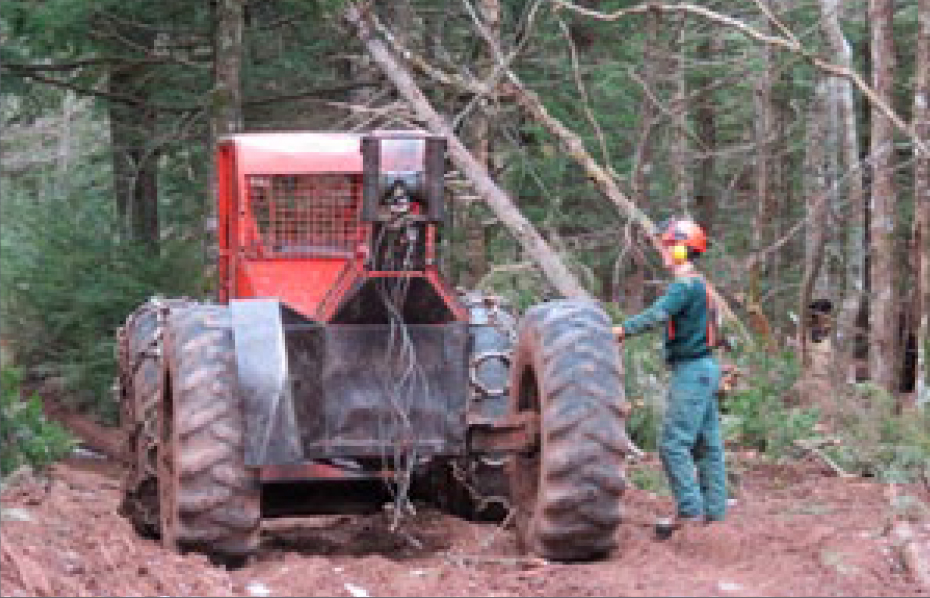 |
| A skidder can be a good choice for wood extraction on small private woodland |
A skidder can be outfitted with a plow for clearing snow, and can be used for dragging site preparation equipment such as shark-fin barrels.
While a skidder is versatile and has many advantages over other extraction methods, it cannot easily create piles of roadside wood convenient for loading on trucks. For this work, a forwarder can more capably pile wood.
Farm Tractors
Farm tractors can be versatile and useful machines on small woodlands. They can be used in a variety of ways, including wood extraction and loading. With a winch mounted on the rear, they can be used in a manner similar to skidders. Tractors are neither as heavy nor as rugged as skidders when used in forestry work. With additional equipment such as cab protectors and skid plates added, a tractor can be “beefed up” to work in the woods. An accessory that is useful and popular is the loader-trailer, which can be used to extract and pile wood in a manner similar to a forwarder, at a much lower cost.
Forwarders (Porters)
By far the most efficient vehicles for extracting cut- to-length wood, forwarders are widely used in most commercial forestry operations. With the capacity for carrying at least 8 tonnes of wood to the side of the road relatively quickly, a forwarder has the capability to keep pace with a harvesting processor. For larger operations, two forwarders are often used.
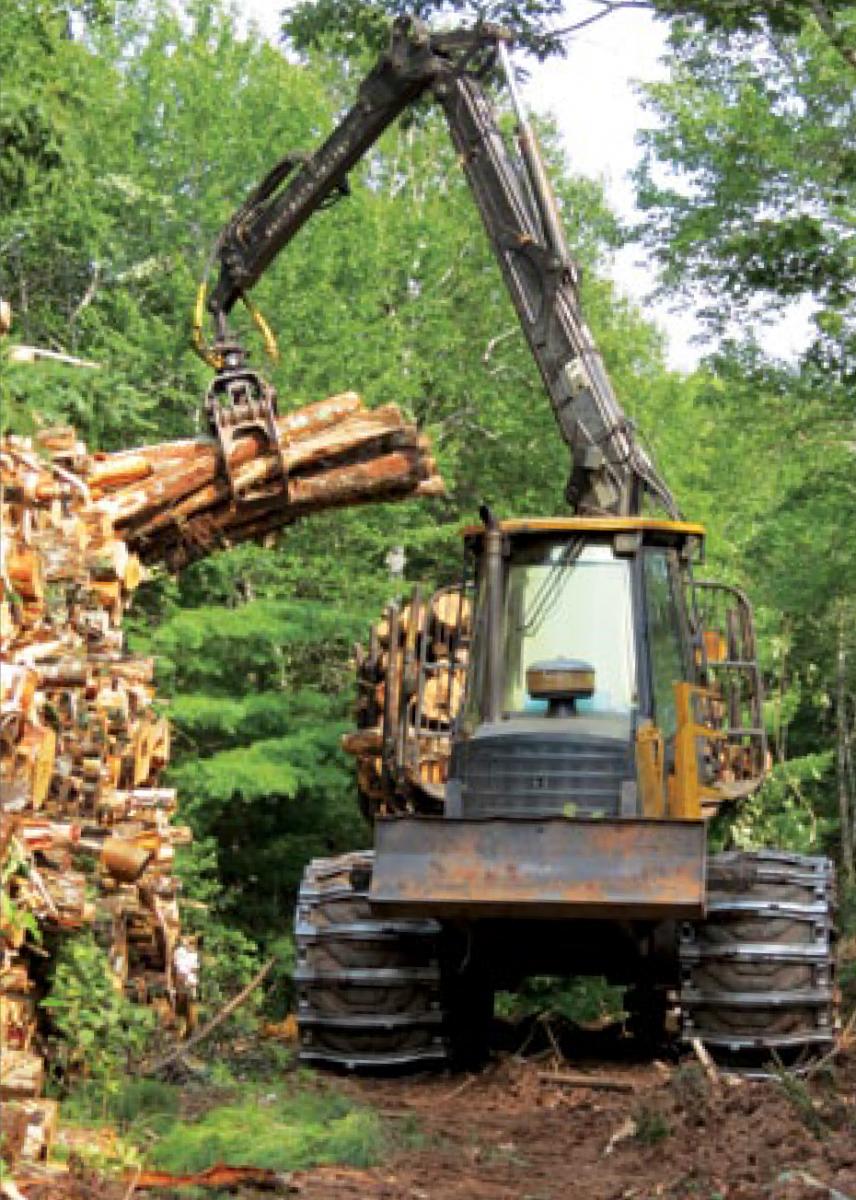 |
| Forwarder piling hardwood |
By literally carrying the wood on its back, a forwarder keeps wood clean and can travel quickly. Modern forwarders have six or eight wheels and can be outfitted with tracks that further reduce soil compaction and rutting.
A forwarder can be brought on-site to collect wood at any time following a harvest by a processor or a crew of chainsaw operators. As long as the wood is not buried in deep snow, a forwarder operator can pick it up and extract it to roadside.
In selection harvesting, where the felling may be done by chainsaw, the layout and configuration of extraction trails is particularly important, since a
forwarder must get very close to the wood it is to collect. If the felling is done with a processor, in most cases a forwarder can use the trails created by the harvester.
Harvesting Contractors
Woodland owners who do not wish to cut their own wood hire forestry contractors to do the work for them. Most contractors have a good knowledge of wood markets and will streamline their operations to accommodate them. When working with a contractor it is a good idea to be as diligent as possible, and implement a written contract, to protect both yourself and the contractor. Refer to Module 14, “Working with a Woodland Contractor”, for further information.
 |
| Every job should be discussed in detail with the harvesting contractor |
Wood is usually sold to a contractor as “standing on the stump”. It is prudent to obtain more than one estimate of what your wood may be worth before it is cut.
Sorting Your Wood
Perhaps one of the most overlooked aspects of timber harvesting is proper sorting. A drive on any gravel road in Nova Scotia will indicate examples of the
consequences of poor planning: neat piles of decaying wood that have been delivered and sorted at the side of a road or landing, but have never been trucked.
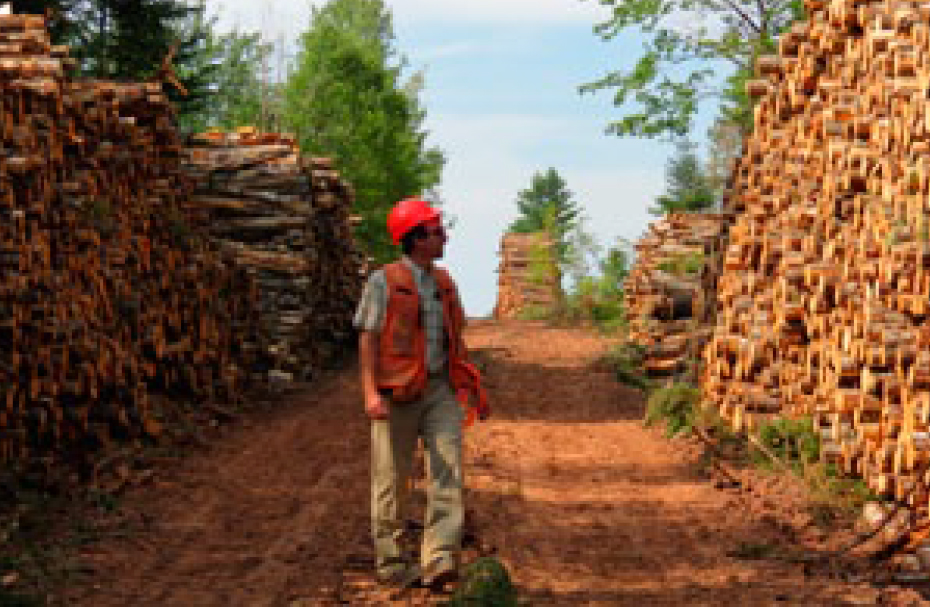 |
| Neatly sorted piles can add value to a harvest |
This problem is easily avoided by having a good knowledge of wood markets and planning your harvest accordingly. Although it may seem extensive, up to 12 different product “sorts” can result from a single harvest, depending on tree species, quality and size. In some woodlands, a typical harvest could include:
• Three or more different lengths of softwood logs
• First grade softwood pulpwood
• Second grade softwood pulpwood
• Softwood studwood (usually for 2x4 or 2x6 lumber)
• Aspen (for oriented strand board)
• Tamarack (for fenceposts)
• Fuelwood
• Low-grade softwood and hardwood for chipping (biomass and wood pellets)
• Hardwood sawlogs and veneer logs
• Hemlock (for bridge stringers)
It is essential to keep in mind that sorting wood at roadside costs money, and you should have markets already secured that make the time and expense of sorting worthwhile. If you are sorting the wood yourself, the sorting must be done in an area that is easily accessible to trucks, usually semi-trailers. These trucks (also called tractor-trailers) are common for hauls over 100 km, or to pulpmills and larger facilities. Tandem trucks are still widely used in Nova Scotia for shorter hauls to sawmills, or for fuelwood delivery.
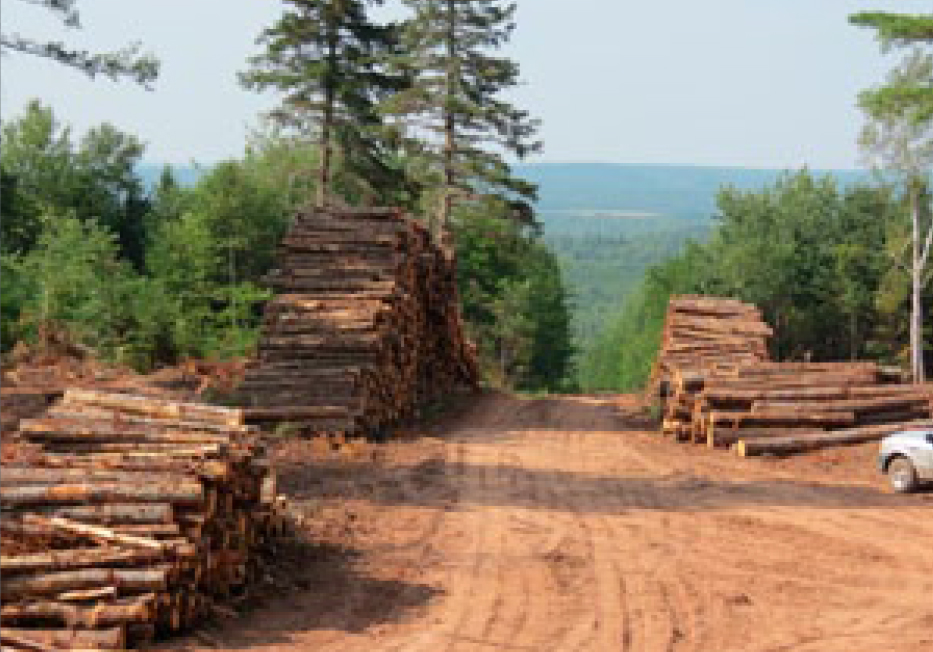 |
| Adequate landings are essential to allow large trucks to turn |
It should be kept in mind that not all trailers are equipped with loaders, and some trucks must be loaded parallel to another truck with a loader. This makes the organization of your landing zone of paramount importance.
When planning any harvest, it is prudent to maximize the return on all forest products. Often, this will result in the sorting of fewer products if markets dictate fewer opportunities. Being responsive to markets is essential to good revenue returns, and it is wise to check local markets before embarking on any harvesting operation. This may involve calling local sawmills, pulp mills, and firewood processors. Or you can simply contact a wood broker, who will do the marketing for you, usually for a fee.
Marketing Your Forest Products
Knowing where and when to sell the wood products that your woodland produces, is absolutely vital if you are planning to harvest timber yourself. Markets exist for nearly every species and size tree that you wish to harvest, but you often need to do a lot of searching.
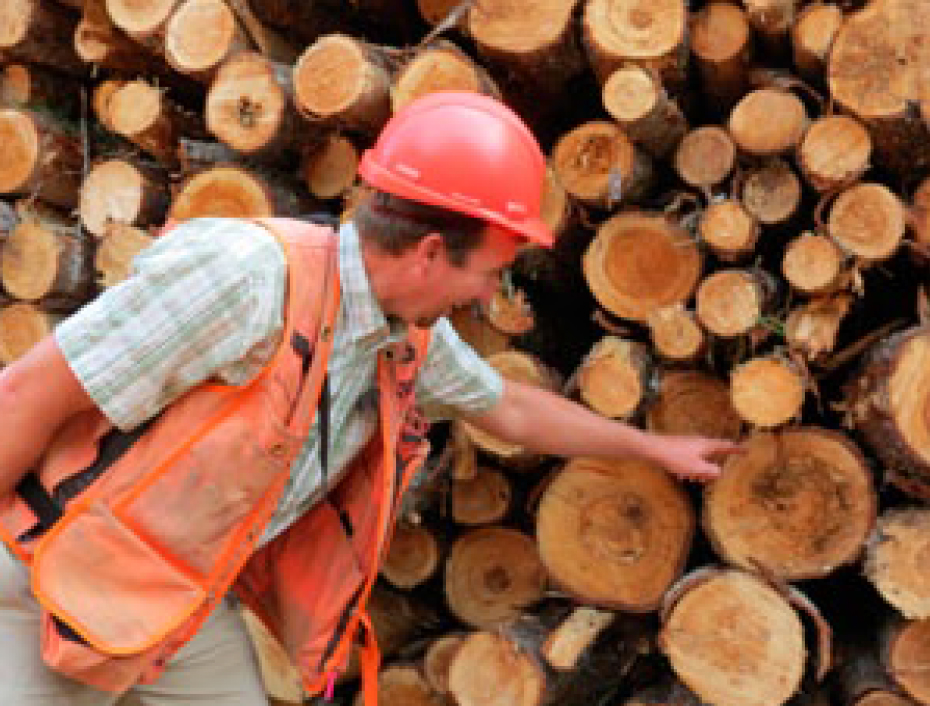 |
| Wood must be graded and sorted for the available markets |
Wood is usually sold by weight (tonne) or volume (cubic meters or cords). Some sawmills still purchase wood by thousand foot-board measure. It is important that you know how to convert metric units to Imperial units – and back again – since not every buyer will purchase wood in the same units as the next.
When hardwood trees are to be harvested for lumber or veneer, it is advisable to ask the mill to send someone to appraise the standing trees. There is a bewildering array of specifications that, if not followed precisely, can negatively influence the prices that you will receive for the wood. For example, an effective log grader can tell you exactly how long to cut the wood for each diameter class, as well as appraise the trees for defects and how to cut the wood for maximum volume and value. A skilled hardwood grader can be your best friend when you wish to produce high-quality hardwood logs.
 |
|
Hardwood should be graded and measured “on the stump” if possible |
Using a broker
Some landowners that do their own harvesting sell their wood through forest products brokers, who will often purchase all the harvested wood and redirect each product to the appropriate mill. Although the buyers usually charge a brokerage fees for this service, it can be well worth the time and effort saved in thoroughly researching the available markets. A broker has an expansive knowledge of the flow of wood products across the entire marketplace, and can be a valuable source of information for a woodland owner.
Every potential wood market has its own set of criteria and standards. These include acceptable species, dimensions of the harvested wood, tolerance for defects and knots (particularly important in hardwood lumber sales), and trucking rates and distances to mills. All of these factors affect wood prices, or even whether a mill will accept the wood. A wood broker has the intimate knowledge that is needed to effectively market your wood.
Access roads and trails
Without good road access it is difficult to effectively harvest a forest stand. If the stand being harvested is more than 300 meters from the landing zone, extra forwarding costs will likely be the result. There is also increased potential that forest soils will be damaged. This, in turn, will reduce the stumpage value of the standing timber. It also results in extra wear and tear on equipment.
If you are forwarding the wood yourself, the size of the forwarding equipment limits the distance over which the wood can be transported. Small-scale equipment such as farm tractors with power trailers is generally restricted to operating within 400 meters of the landing zone. Horses and oxen are typically limited to the same distance.
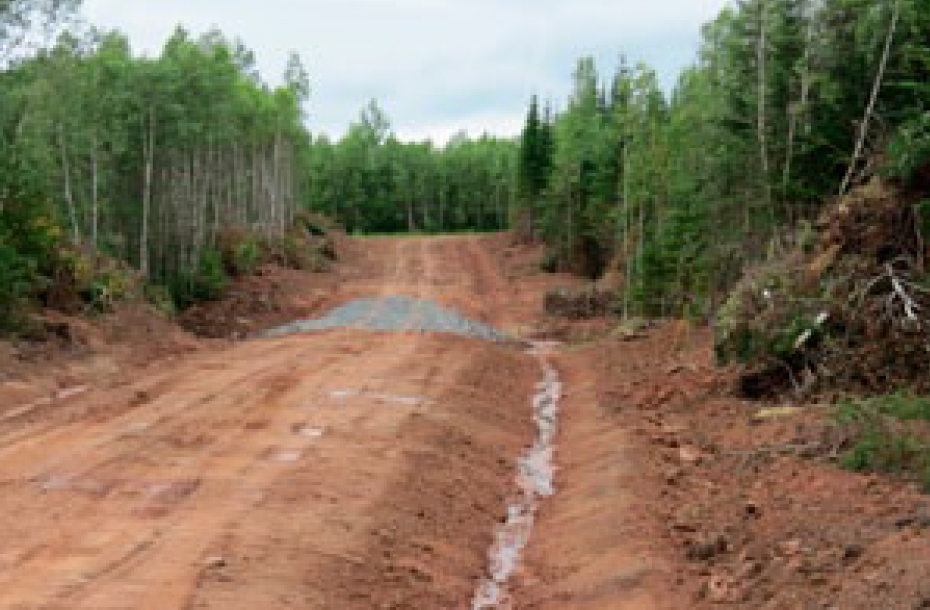 |
| This newly-constructed access road will be essential for safe and efficient harvesting |
With larger forwarding equipment such as skidders and forwarders, distance to the landing zone can be increased. While cable skidders are not as common as they once were, they are still effective in dragging cut- to-length, random-length and tree-length wood to the landing zone. Older-model skidders are popular with woodland owners that have a knack for mechanics. Skidders can be also outfitted with snowplows for clearing forest roads. They are particularly useful for extracting single large trees from the woods by cable, or for winching trees up steep slopes.
Modern forwarders have the capability to forward wood for long distances (up to a kilometer). With most forwarders able to carry more than 8 tonnes (4 cords) of wood, it is important to locate extraction trails that will afford the most straightforward routes of travel. Watercourses, wetlands and rugged terrain will also influence the location of forwarder trails.
For more information on forest road and trail construction refer to Module 11.
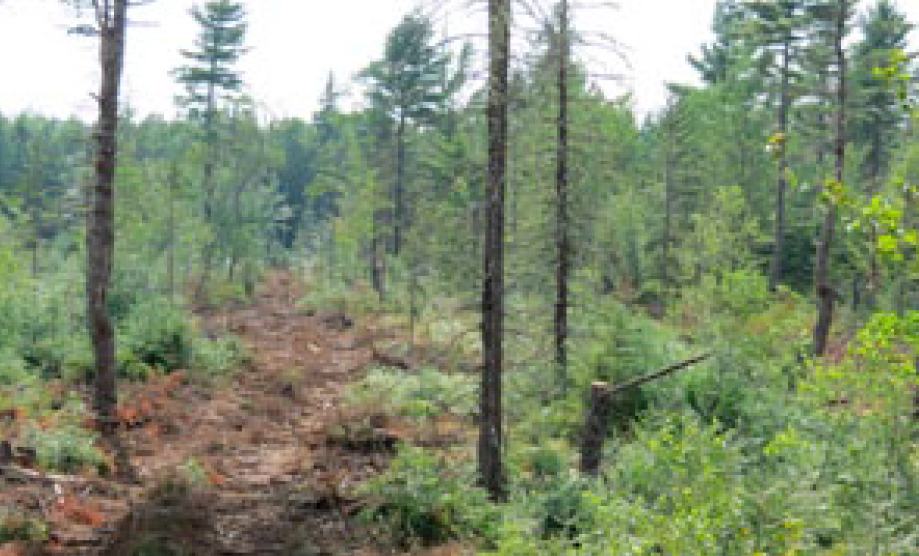 |
| Forwarder trails should be located to avoid damaging advanced regeneration. |
Case Study 1
The MacIvers had owned farmland in Pictou County for more than two centuries. Since the original MacIver had emigrated from Scotland in 1793, the farm had seen seven generations of families.
Although many acres of MacIver land had been carved off over the years, Ian still owned 300 acres (121 ha) of the original farm. More than two-thirds of it was still agricultural fields.
As the beef industry had declined, whole farms had been abandoned. On the MacIver place, the upper pastures had fallen into disuse. Ian’s father could recall the small patches of speckled alder that first became established on the moister sites of the pasture, where the cattle used to gather during the hottest summer days. Over the rest of the pasture, white spruce had seeded and grown. Patchy at first, then covering the pastures like a thick green carpet, the spruce seemed to out-grow everything else. Pasture spruce, Ian’s father had called it. Cat spruce, one of the neighbors had termed it. And those were the polite names.
For more than fifty years the spruce had grown, without tending or management. “The Desperate Place,” his father had called it before he died. Many of the trees were open-grown, with branches growing from the whole length of the trunk. These limbs were long and many of the crowns were turning reddish-orange, a sure sign that something was amiss. Ian was concerned, since he didn’t want this malady to affect his plantations. He called a local forest professional to ask him to take a look.
Alex the forest technician didn’t take long in reaching a conclusion. “Spruce bark beetle,” he stated, and showed Ian the tiny exit holes in the bark where the beetles had fed, pupated, emerged as adults and escaped. Alex pulled off a patch of bark and Ian could see the insect galleries etched into the wood. With sap prevented from carrying water and nutrients between roots and crown, the needles could not carry out photosynthesis and the tree was dying.
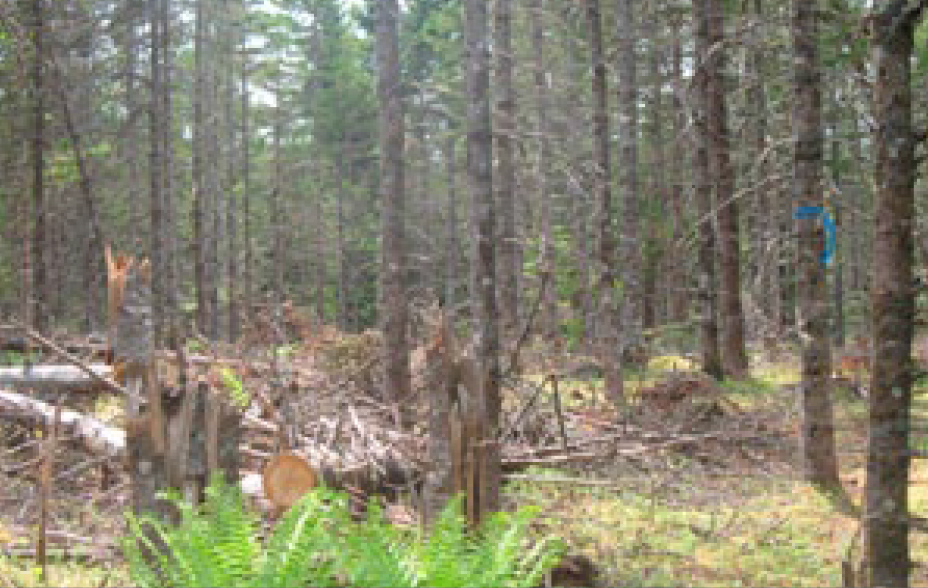 |
The forest technician recommended harvesting the stand as soon as possible to prevent further mortality in both this stand and adjacent ones. Ian wondered whether he should harvest only the affected trees. “You’ll be back harvesting again next year,” said Alex, “and you’ll likely be cleaning up blowdowns too.” He pointed to the forest floor, where the shallow rooting of the spruce was evident. “If this field was plowed at some time in the past, there is a hardpan layer about a half-meter down, which prevents deep rooting.” Ian could remember his father plowing the fields in the 1960s.
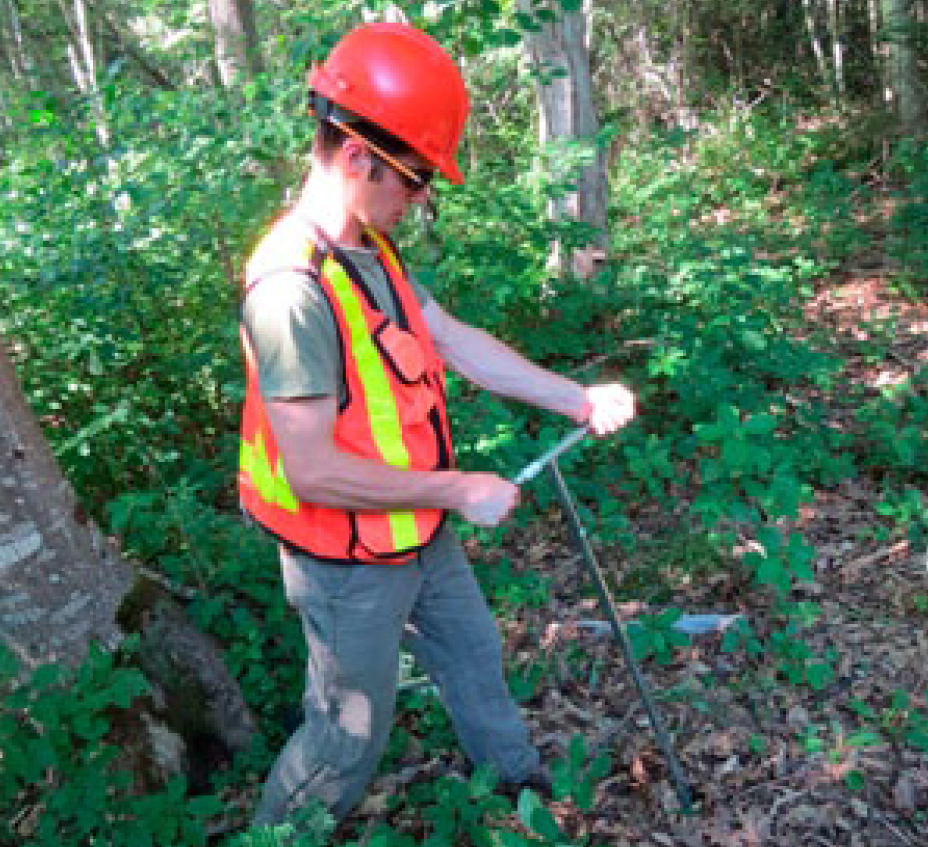 |
Ian watched Alex as the forest technician twisted his soil auger into the ground to take a soil sample. He could see the change in soil conditions at about 40 cm, where the loose upper soil lay on top of a hard layer, which was nearly impervious to tree roots. “That’s the hardpan,” said Alex. “I will carry out some pre-treatment assessments on this site, and they will likely show the same results. After that, I can recommend a couple of good harvesting contractors if you’re interested.”
Ian was indeed interested.
Over the next week two contractors visited the MacIver woodland and Ian was impressed with their attention to detail. Because an old farm road was within 100 meters (312-feet) of the stand, a new road was not necessary. There was a place where semi-trailers could get turned and an area for piling the wood. The road culverts seemed to be in good shape, and a little gravel was all that was needed.
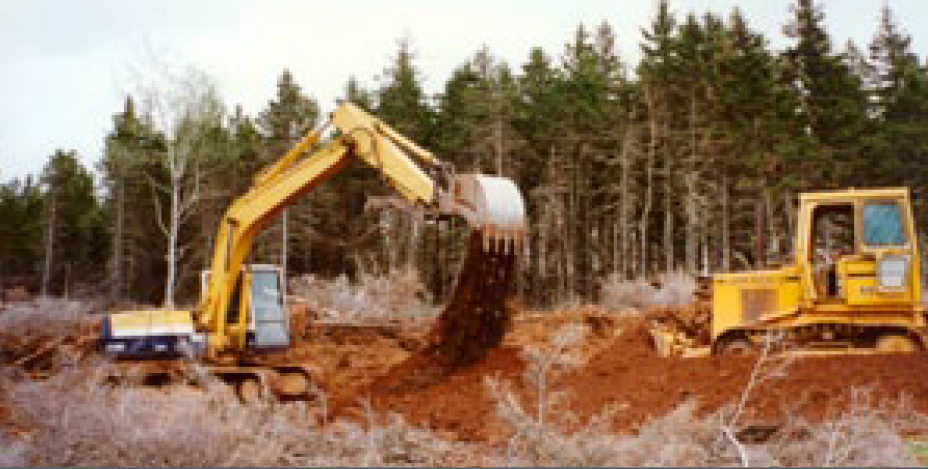 |
Ian knew that he would have to declare his income on the wood when he was paid for it, so he talked with his accountant to sort out the best method of payment. He found he could claim it as farm income and could charge the cost of the gravel against the wood. Both contractors’ offers were similar and Ian settled on a lump-sum stumpage payment with one of them. The contractor indicated that if he damaged the road during the harvesting or trucking operations, he would repair it at no additional charge. Ian could now consider this a hands-off operation, which suited him just fine.
About a month later, a flatbed trailer arrived carrying a harvesting processor. The contractor arrived soon afterward and together with Ian, flagged out the site to be harvested. It was close to 10 hectares (25-acres) in area. Legacy/wildlife clumps would need to be left to meet the provincial wildlife regulations, and they flagged these as well.
That afternoon the harvester began felling and delimbing trees along the edge of the stand. Not surprisingly, the harvester operator avoided cutting several of the largest, limbiest trees. These were left for the forwarder operator, who was also skilled at manual felling by chainsaw.
Ian marveled at the seeming ease with which the harvester cut each tree a stump height and ran the processing head up the trunk to shear off the limbs. The head then back-tracked and cut the trunk at about eight-foot intervals. He later found out that these cuts were determined by an onboard computer, which was optimizing the wood length for studwood. Wood that was too small in diameter, such as the upper trunk, was processed for pulpwood.
The harvester computer handled the tediousness of this cut-to-length system, reducing the operator’s need to make decisions based on the diameter of the wood. The six-wheel-drive vehicle was able to climb the hill as it worked, and soon neat rows of freshly cut wood formed regimented lines up the hillside. The operator had sheared the limbs directly in front of the harvester, and placed the cut wood off to one side, so the harvester had a mat of limbs and brush on which to travel.
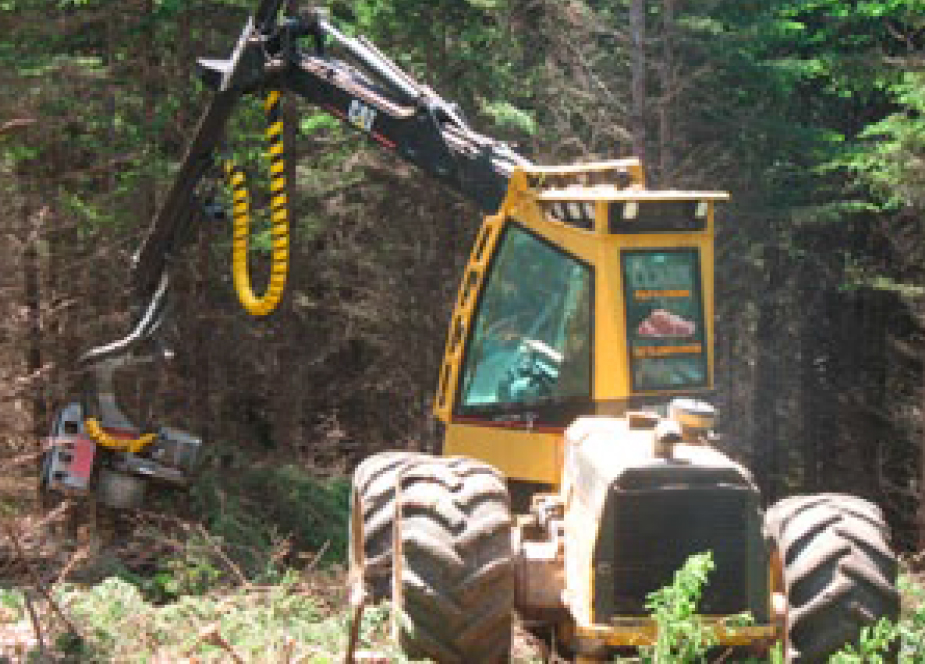 |
Two days later the forwarder arrived, delivered sometime during the night. The harvester had been working 10-hour days, and had a substantial volume of wood ready to be picked up. Ian watched as the forwarder operator travelled the same trail of brush as the harvester, and efficiently used the boom and grapple to load two tiers of wood onto the eight-wheel-drive vehicle.
Once full, it crawled back to the side of the road and off-loaded the wood. Ian could see that each set of wide, tandem tires had tracks attached. With over 10-tonnes of wood, the forwarder left remarkably little imprint on the surface of the forest floor.
Within a couple of days the wood had been piled high on the side of the road. Trucks began to arrive, loading the wood. Nearly all the studwood was trucked first, and then two trucks arrived for the pulpwood, of which there was surprisingly little. Ian counted over fifty truckloads leaving, and knew he didn’t see them all.
A week later the job was finished. The forwarder had caught up to the harvester relatively quickly, and there were two days when the forwarder operator manually felled and delimbed the trees the harvester could not process. There were two islands of trees – flagging tape still attached to the perimeters – left as legacy/wildlife clumps.
Ian thought the site looked barren compared to what it had been, but he remembered that this was once a field. With the trees removed, the ground was remarkably level.
Alex the forest technician had given him the name of a tree planting contractor because - he was surprised to learn – this site would not regenerate on its own for many years. And, Alex cautioned, it would be wise to wait a couple of years before planting, since an insect called the root-collar debarking weevil tended to chew the tender parts of seedlings that were planted too soon after the site was harvested. This was especially the case on white spruce cutovers.
Ian was pleased that the whole operation had proceeded so smoothly. The harvester and forwarder had disappeared the same night they had completed work on the woodland. His neighbor told him the crew was working a few kilometers down the road, performing a selection harvest.
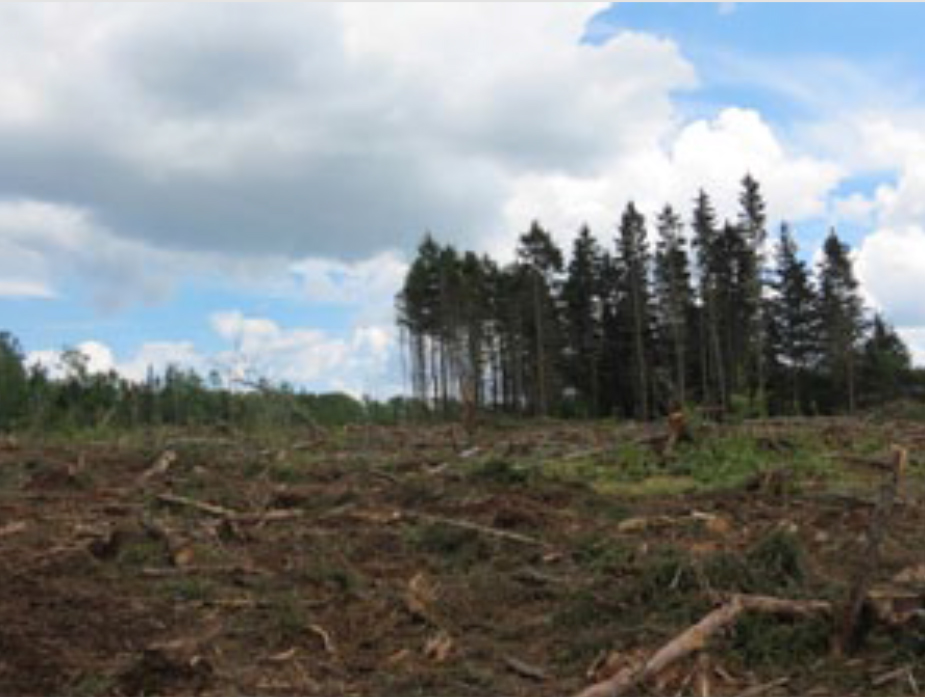 |
Ian thought about the north end of his property where his father and grandfather had spent most winters, cutting logs for beams and walls. He didn’t have the time or the equipment to revisit that stand, which had remained untouched for the last 30 years. He was interested in the results that selection management had to offer.
Perhaps he would go and have a word with the contractor about his availability next winter.

